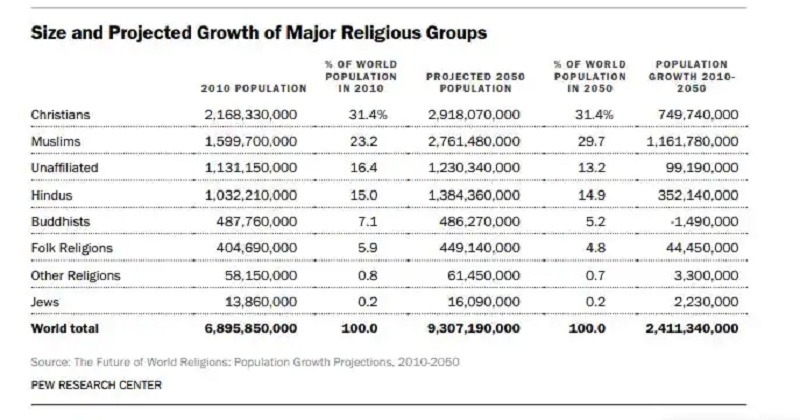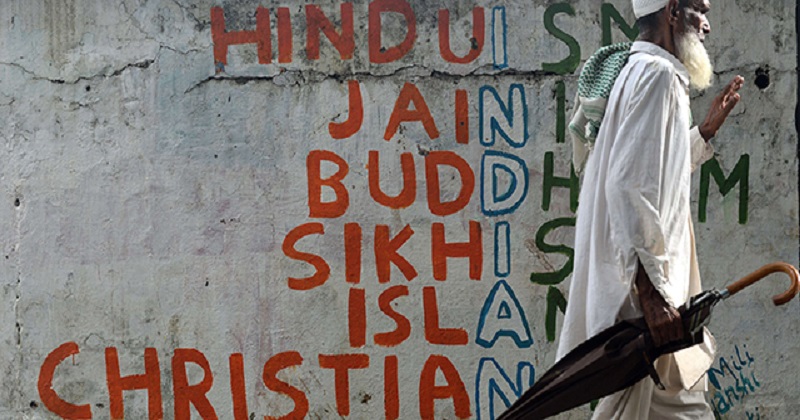
Pew Research Center, an independent think tank in Washington DC, published a recent report finding that Indians give importance to religious freedom, value religious tolerance, and believe the idea of India should embrace all religions. Pew surveyed 29,999 Indian adults between late 2019 and early 2020, weeks before the COVID-19 pandemic hit.
Pew Research Center’s study describes new demographic projections that take into account the current size and geographic distribution of the world’s major religions, age differences, fertility and mortality rates, international migration patterns, and conversion patterns. In addition, the Pew study looked closely at religious identity, nationalism and tolerance within Indian society. Almost all six major religious groups surveyed by Pew, including Hindus, Muslims, Christians, Jains, Sikhs and Buddhists, believe they are very free to practice their faith.


In contrast, almost every religious group shows a preference for preserving religious communities’ segregation and ‘wants to live separately’. Almost all the states and union territories of India were covered in the Pew Research Center survey conducted in 17 languages.
For Indians, religion is important
- 97% of Indians believe in God, according to the Pew study. Religion holds a special place in their hearts.
- In most religious groups, around 80% of the people believe there is a God.
- In India, cows are considered sacred animals.
- In India, 72% of Hindus believe one cannot be a Hindu if they eat beef. According to this percentage, a person cannot be Hindu if they do not worship God (49%) or never go to a temple (48%).
- As God is not the center of Buddhist teachings, one-third of the followers claim to not believe in him.
- Around 74% of Muslims want access to their own religious courts to resolve matters relating to family and inheritance, according to the Pew survey.
- Muslims in India have had the option of resolving family and inheritance-related disputes in recognized Islamic courts, called dar-ul-qaza, since 1937, but their decisions are not legally binding.
- Pew also took into account Indians’ opinions regarding interfaith marriage in the study. 66 percent of Hindus are against getting married to someone of another religion.
- Apart from this, 78 percent of Muslims, 36 percent of Christians, 47.5% of Sikhs, 45 percent of Buddhists and 62.5% of Jains also object to marriages between people of different religions.
- Hindus celebrate Diwali as their biggest festival. In the Pew study, in addition to 95 percent Hindus, 20 percent Muslims, 31 percent Christians, 90 percent Sikhs, 79 percent Buddhists and 98 percent Jains celebrate the festival of Diwali, showing there is a strong bond between all religions in India.
- The Pew study estimates that India will retain a Hindu majority but will also have the world’s largest Muslim population, surpassing Indonesia.
- The Hindu population is projected to grow by 34% worldwide, from just over 1 billion to nearly 1.4 billion, roughly keeping pace with overall population growth.
- Pew data reveal that Indians believe their country has lived up to one of its post-independence ideals: a society where people of many religious beliefs are free to practice their faith.

Study findings
Globally, the religious profile is changing rapidly, owing to the large differences in fertility rates and the size of youth populations among major religions, in addition to the conversion of people to new faiths. Despite Christian dominance, Islam will increase more rapidly than any other major religious group over the next four decades. By 2050, if current trends continue:
- Around the world, the number of Muslims will nearly equal the number of Christians.
- Atheists, agnostics, and other non-religious people will make up a decreasing percentage of the global population.
- There will be a similar proportion of Buddhists as there was in 2010 whereas the Hindu population and the Jewish population will be larger.
- Muslims make up 10% of the overall population in Europe.
- By 2050, the number of Christians in the United States will fall from more than three-quarters to two-thirds, and Judaism will become the largest non-Christian religion.
- Muslims will be more numerous in the US than people who identify as Jews on the basis of religion.
- Four out of every ten Christians in the world live in sub-Saharan Africa.
Read more: Canada fines travellers for fake vaccination and testing documents
Further, the study predicts that Islam will almost catch up with Christianity by the middle of the 21st century if current demographic trends continue. A 35% increase in the world population is expected between 2010 and 2050. The study predicts that by 2050 there will be close to parity between Muslims (2.8 billion, or 30% of the population) and Christians (2.9 billion, or 31%), possibly for the first time in human history. Due to low fertility rates and aging populations in countries such as China, Thailand and Japan, the global Buddhist population is expected to be relatively stable.

Post Your Comments